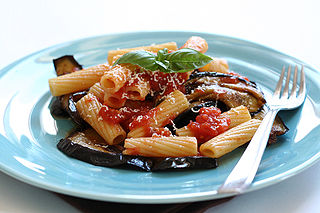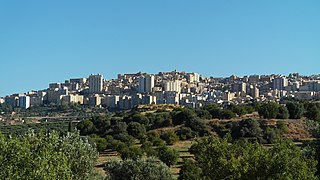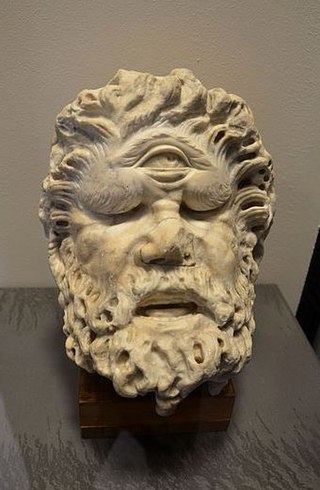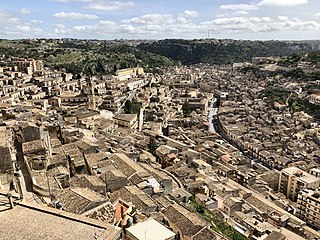This article needs additional citations for verification .(November 2024) |
Mount Alveria is a mountain located in the Province of Siracusa, south-eastern Sicily, Italy.
This article needs additional citations for verification .(November 2024) |
Mount Alveria is a mountain located in the Province of Siracusa, south-eastern Sicily, Italy.
This mountainside has been inhabited since prehistoric times. The Elymians lived there before the 10th century B.C. They were followed by the Sicani and then the Siculians. Many Bronze Age artifacts have been found in this locality. One of the oldest archeological sites in the area is the Necropolis of Castelluccio thought to date from the 17th-15th centuries BC. The Roman Villa of Tellaro has also been excavated on Mount Alveria.
Mount Alveria was the original site of the city of Noto. Noto was relocated to a more level site 10 kilometres away after the earthquake of 1693. The ruins of the old city of Noto, known today as Noto Antica, still remain on a ridge on the mountainside. [1] [2]

Marcus Tullius Cicero was a Roman statesman, lawyer, scholar, philosopher, writer and Academic skeptic, who tried to uphold optimate principles during the political crises that led to the establishment of the Roman Empire. His extensive writings include treatises on rhetoric, philosophy and politics. He is considered one of Rome's greatest orators and prose stylists and the innovator of what became known as "Ciceronian rhetoric". Cicero was educated in Rome and in Greece. He came from a wealthy municipal family of the Roman equestrian order, and served as consul in 63 BC.

Sicily is an island in the central Mediterranean Sea, south of the Italian Peninsula in continental Europe and is one of the 20 regions of Italy. With 4.8 million inhabitants, including 1.3 million in and around the capital city of Palermo, it is the most populous island in the Mediterranean Sea. It is named after the Sicels, who inhabited the eastern part of the island during the Iron Age. Sicily has a rich and unique culture in arts, music, literature, cuisine, and architecture. Its most prominent landmark is Mount Etna, the tallest active volcano in Europe, and one of the most active in the world, currently 3,357 m (11,014 ft) high. The island has a typical Mediterranean climate. It is separated from Calabria by the Strait of Messina. It is one of the five Italian autonomous regions and is generally considered part of Southern Italy.

Syracuse is a historic city on the Italian island of Sicily, the capital of the Italian province of Syracuse. The city is notable for its rich Greek and Roman history, culture, amphitheatres, architecture, and as the birthplace and home of the pre-eminent mathematician and engineer Archimedes. This 2,700-year-old city played a key role in ancient times, when it was one of the major powers of the Mediterranean world. Syracuse is located in the southeast corner of the island of Sicily, next to the Gulf of Syracuse beside the Ionian Sea. It is situated in a drastic rise of land with 2,000 metres (6,600 ft) depths being close to the city offshore although the city itself is generally not so hilly in comparison.

Sicilian cuisine is the style of cooking on the island of Sicily. It shows traces of all cultures that have existed on the island of Sicily over the last two millennia. Although its cuisine has much in common with Italian cuisine, Sicilian food also has Greek, Spanish, French, Jewish, Maghrebi, and Arab influences.

Agrigento is a city on the southern coast of Sicily, Italy and capital of the province of Agrigento.

In Greek mythology and later Roman mythology, the Cyclopes are giant one-eyed creatures. Three groups of Cyclopes can be distinguished. In Hesiod's Theogony, the Cyclopes are the three brothers, Brontes, Steropes, and Arges, who made Zeus's weapon, the thunderbolt. In Homer's Odyssey, they are an uncivilized group of shepherds, the brethren of Polyphemus encountered by Odysseus. Cyclopes were also famous for being the builders of the Cyclopean walls of Mycenae and Tiryns.

Typhon, also Typhoeus, Typhaon or Typhos, was a monstrous serpentine giant and one of the deadliest creatures in Greek mythology. According to Hesiod, Typhon was the son of Gaia and Tartarus. However, one source has Typhon as the son of Hera alone, while another makes Typhon the offspring of Cronus. Typhon and his mate Echidna were the progenitors of many famous monsters.

Noto is a city and comune in the Province of Syracuse, Sicily, Italy. It is 32 kilometres (20 mi) southwest of the city of Syracuse at the foot of the Iblean Mountains. It lends its name to the surrounding area Val di Noto. In 2002 Noto and its church were declared a UNESCO World Heritage Site.

The province of Syracuse was a province in the autonomous island region of Sicily, Italy. Its capital was the city of Syracuse, a town established by Greek colonists arriving from Corinth in the 8th century BC. It had an area of 2,109 square kilometres (814 sq mi) and a total population of 403,985 (2016). Syracuse had 8% of the Sicilian population and 8.2% of Sicily's area.

Sicilian Baroque is the distinctive form of Baroque architecture which evolved on the island of Sicily, off the southern coast of Italy, in the 17th and 18th centuries, when it was part of the Spanish Empire. The style is recognisable not only by its typical Baroque curves and flourishes, but also by distinctive grinning masks and putti and a particular flamboyance that has given Sicily a unique architectural identity.

Val di Noto is a historical and geographical area encompassing the south-eastern third of Sicily; it is dominated by the limestone Hyblaean plateau. Historically, it was one of the three valli of Sicily.

Modica is a city and comune of 54,456 inhabitants in the Province of Ragusa, Sicily, southern Italy. The city is situated in the Hyblaean Mountains.
Giovanni Battista Landolina, "Marchese di S. Alfano", was a Sicilian landowner and intellectual instrumental in having the city of Noto removed from its former site on Mount Alveria to a more level location following the earthquake in 1693 centred on the Val di Noto. He is commemorated by a piazza in the city named in his honour.

The Punic people, usually known as the Carthaginians, were a Semitic people who migrated from Phoenicia to the Western Mediterranean during the Early Iron Age. In modern scholarship, the term Punic, the Latin equivalent of the Greek-derived term Phoenician, is exclusively used to refer to Phoenicians in the western Mediterranean, following the line of the Greek East and Latin West. The largest Punic settlement was Ancient Carthage, but there were 300 other settlements along the North African coast from Leptis Magna in modern Libya to Mogador in southern Morocco, as well as western Sicily, southern Sardinia, the southern and eastern coasts of the Iberian Peninsula, Malta, and Ibiza. Their language, Punic, was a variety of Phoenician, one of the Northwest Semitic languages originating in the Levant.

The 1693 Sicily earthquake struck parts of southern Italy near Sicily, then a territory part of the Crown of Aragon by the Kings of Spain Calabria, and Malta on 11 January at around 21:00 local time. This earthquake was preceded by a damaging foreshock on 9 January. The main quake had an estimated magnitude of 7.4 on the moment magnitude scale, the most powerful in Italian recorded history, and a maximum intensity of XI (Extreme) on the Mercalli intensity scale, destroying at least 70 towns and cities, seriously affecting an area of 5,600 square kilometres (2,200 sq mi) and causing the death of about 60,000 people.

Tomorr is a mountain chain in the region of Berat and Skrapar, in Albania. It reaches an elevation of 2,416 metres (7,927 ft) above sea level at the Çuka e Partizanit, which is the highest peak in central Albania.

Ancient Carthage was an ancient Semitic civilisation based in North Africa. Initially a settlement in present-day Tunisia, it later became a city-state and then an empire. Founded by the Phoenicians in the ninth century BC, Carthage reached its height in the fourth century BC as one of the largest metropoleis in the world. It was the centre of the Carthaginian Empire, a major power led by the Punic people who dominated the ancient western and central Mediterranean Sea. Following the Punic Wars, Carthage was destroyed by the Romans in 146 BC, who later rebuilt the city lavishly.

Noto Cathedral is a Roman Catholic cathedral in Noto in Sicily, Italy. Its construction, in the style of the Sicilian Baroque, began in the early 18th century and was completed in 1776. It is dedicated to Saint Nicholas of Myra, and has been the cathedral of the Diocese of Noto since the diocese's establishment in 1844.

Angelo Italia was an Italian Jesuit and Baroque architect, who was born in Licata and died in Palermo. He designed a number of churches in Sicily, and later worked to reconstruct three cities following the 1693 Sicily earthquake.

Palazzo Ducezio is the town hall of the town of Noto, in Sicily.